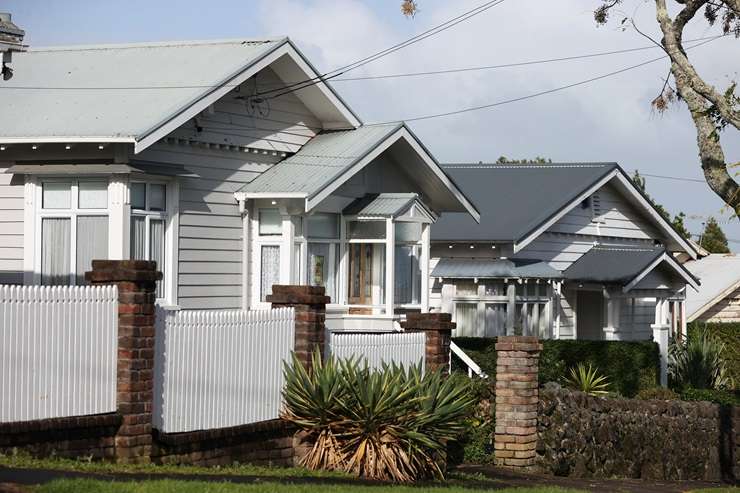A lot is happening in the housing market but bank economists are only tweaking their predictions for a somewhat flat year ahead.
Factors at play include a hike in listings but immigration is still strong. Policy changes by the Coalition Government favour landlords with the reinstatement of interest deductibility and the reversal of the bright-line test back to two years.
At its last meeting the Reserve Bank held the Official Cash Rate (OCR) at 5.5% and is now predicting house prices will rise around 3.4% this year.
And last week figures from Stats NZ showed the economy had slid back into a recession in the fourth quarter of last year.
Start your property search
OneRoof spoke to economists from the major banks to find out if they had revised their forecasts for the year, to find most had not moved much.
Miles Workman, senior economist with the ANZ, said there were a lot of moving parts in the housing market with macroeconomic forces, such as high net migration, at play on top of the Government’s policy changes and the data was “evolving”.
Along with the policy changes there was potential for mortgage rates to decline slightly this year, because if the Reserve Bank had finished hiking the OCR wholesale markets would start pricing in cuts, he said.
However, the labour market was likely to loosen and the impact of that on household incomes was yet to be seen.
“That’s still a bit of an open question but ultimately when the labour market is loosening households won’t feel as secure with their job prospects and this can affect their appetite to borrow and, therefore, buy houses.”
All the factors rounded out to a modest outlook: “We have house prices growing over 2024 by around about 3%, lifting to around about 5% over 2025.”
Read more:
- Tony Alexander: Survive to '25 - why we're all holding on till interest rates drop
- Warning to first home buyers as ANZ gives property investors a leg up
- Grand Designs NZ: TV show house that blew the budget for sale again
But Workman said he would not be surprised if those numbers were out on either side.
“I think when you look at the housing data at the moment there’s mixed indicators everywhere. You’ve got inventories which are lifting, you’ve got days to sell which are lifting.
“Sales are recovering but they are still below historical levels for this time of year, so lots of moving pieces.”
Unknown also was whether there were investors waiting in the shadows ready to pounce when they had certainty, and likewise first-home buyers.
“It’s really hard to know how much coiled up spring dynamics are in the demand pile so it’s certainly something we are going to be watching very closely.”
Workman said economic forecasters always struggled with house price forecasting, because of the moving parts.
“That’s partly because a lot of the inputs, things like migration, some of those macroeconomic inputs, they do impact the housing market and they themselves are very difficult to forecast.”

BNZ chief economist Mike Jones: "Over time I think we will see some of that pressure in the rental market spill over into the housing market.” Photo / Fiona Goodall
Mike Jones, chief economist for the BNZ, said their economists were still comfortable with the view the OCR had peaked with cuts likely in November, with the caveat there was plenty of water to still flow under the bridge before then.
“I think where it has been changed is we have just lowered our house price forecast slightly. Where you were at 7%, we nosed it down to 5%.
“It’s more symbolic than anything particularly material but we don’t really see any house price inflation now over the first half of this year so we have back loaded the increases we had into the second-half.”
That was because current conditions depicted the housing market as flatlining and that was unlikely to change while interest rates and mortgage rates remained high, he said.
The second half of the year could see the impact of a significant underbuild of houses – a BNZ analysis recently predicted 45,000 to 50,000 more residential dwellings were needed this year to accommodate the record population growth being seen.
“We don’t think we will build enough houses for the population growth that we are seeing so we are already seeing some of that pressure turn up in the rental market, not so much in the housing market so far but over time I think we will see some of that pressure in the rental market spill over into the housing market.”
Nick Tuffley, chief economist for the ASB, was still picking a 7.3% house price increase this year.

Higher interest rates have put the squeeze on homeowners. Photo / Getty Images
Interest rates were likely to go down later this year and there should be a gradual recovery in the housing market over the year which was likely to be more noticeable in the second half of the year.
“The market’s pretty much doing what we had been expecting it would do.
“It’s a slow recovery at this point because you still do have interest rates at relatively high levels but you do have all the positive factors that are there, like the immigration flows are still very high, you’ve got pressure on the rental market which is making at least the returns look slightly better than otherwise, and the property-related tax changes will make a difference over time.”
Investors could buy knowing they would get full interest deductibility back soon – but they needed to be wary that tax policy, particularly around property, was at more risk of swinging around from one change of government to another, he said.
“Going forward we think investors would need to put a greater weight on factors like that when they’re making their decisions.
“Things won’t be set in stone forever, from the changes the previous government made and now the unwinding of those changes the current government is making, you need to be a lot more cognizant of potential for change to happen again at some stage in the future.”

Westpac chief economist Kelly Eckhold: "House sales and pricing has generally been at pretty subdued levels." Photo / Fiona Goodall
Putting that aside, in the short-term the tax changes were positive for investors’ calculations and with the strong population growth and building activity starting to slow the shortage of properties was likely to build again.
“You’ve got the supply challenges at a time when demand is pretty strong from a population point of view, and as interest rates do fall more noticeably once the Reserve Bank cuts the cash rate we would expect to see the market gather much more of a head of steam over 2025.”
Tuffley expected the Reserve Bank to start cutting the OCR from November and steadily cut it at 25 basis points each meeting back to 3% around early 2026 resulting in fixed mortgage rates somewhere in the range of mid-5%s to low 6%s, give or take.
Kelly Eckhold, Westpac’s chief economist, said they had downgraded their house price forecast in their last economic overview from close to 8% down to 6% for this year, reflecting the flat housing market seen since the election.
“It certainly does look like house sales and pricing has generally been at pretty subdued levels,” he said.
“Prices are not falling really but they also seem to have stopped going up for the time being.”
With the changes in the housing market, he said the year would still be a decent one because population growth seemed strong and interest rates were likely at their peak now.
He put weight on the impact of population growth on house prices.
“One expression of the demand that we see from this quite exceptional population growth is in rents which are running at pretty strong levels.
“Rents are sitting closer to the 6% or 7%-type level on an annual basis depending on what part of the country you’re looking at.”
That showed there was a demand for accommodation and while a lot of recent migrants might not have the resources immediately to buy property, they did need to rent.
Westpac recently put out a report which said with the population growth there would be a need for 125,000 more houses over the next few years, but it was unlikely that many would be built, he said.
Use the search field to find out the best mortgage deals available today.













































































